Thursday 29 November, 2012, 04:07 - Licensed
Posted by Administrator
The local TV landscape in the UK is slowly taking shape as the decision on the final, and arguably the most commercially viable/advantageous franchises is delayed to give Ofcom more time to make the right decision. Whilst decisions on which companies will succeed in the lucrative markets of London, Leeds and Liverpool are still outstanding, also still to be announced is who will supply the transmission services for the local TV stations. Four bidders emerged when Ofcom invited tenders to deliver the local TV multiplexes:Posted by Administrator
 Avanti Local TV (backed by broadband satellite company Avanti Communications – plans to use small transmitters to provide coverage tailored to local TV audiences)
Avanti Local TV (backed by broadband satellite company Avanti Communications – plans to use small transmitters to provide coverage tailored to local TV audiences) Comux UK (backed by Canis Media who run the local TV multiplex in Manchester – a group of consultants who will provide their expertise to local TV companies to help them get going)
Comux UK (backed by Canis Media who run the local TV multiplex in Manchester – a group of consultants who will provide their expertise to local TV companies to help them get going)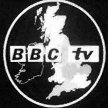 LMux Ltd (backed by the BBC – will shepherd the roll-out of the network in good old BBC style, and keep it going with any available funds until such time as those funds run out)
LMux Ltd (backed by the BBC – will shepherd the roll-out of the network in good old BBC style, and keep it going with any available funds until such time as those funds run out) Local TV Multiplex Ltd (backed by the Community Media Association – will act as a central procurement facility to try and negotiate down prices of transmitters and other services for local TV companies)
Local TV Multiplex Ltd (backed by the Community Media Association – will act as a central procurement facility to try and negotiate down prices of transmitters and other services for local TV companies)The majority of the bidders will rely on existing television transmitter sites to provide the coverage for the local TV multiplexes. This has a number of advantages, not least that viewers’ TV antennas will be pointing in the right direction and (hopefully) will be of the correct antenna group to receive the transmissions. Historically, however, placing local television transmitters on larger transmitter towers has not necessarily offered an ideal solution.
Lanarkshire TV (LTV, later rebranded as Thistle TV) used the main Black Hill transmitter site situated between Glasgow and Edinburgh, both of which it covers. The old analogue TV transmissions on Black Hill used a power of 500 kW whereas LTV only had around 10kW of power. At 500 kW coverage of the region is excellent, at 10 kW (50 times or 17 dB less), coverage is marginal at best. Even close to the mast where the lower power signal is notionally strong enough to provide good reception, viewers receivers will be set up to receive the stronger signals (ie antennas will be of lower gain, or even indoor) and the large disparity in signal strength will render the lower power station largely unwatchable.
A similar (but worse) situation occurred on the Isle of Wight where not only was the local TV station Solent TV (and its predecessor TV12) using only 2 kW compared to the power of the main station of 250 kW but it was also on an ‘out of group’ channel.
 The main transmitter at Rowridge uses channels at the lower end of the UHF TV band (channels 21 to 31 were used for analogue services), whereas Solent TV was on channel 54, meaning that not only was it 21 dB weaker leaving the transmitter due to its lower power (worse even than Lanarkshire TV) but the TV antennas of viewers (which are ‘grouped’ in order to focus their gain on the frequencies being used in the area) would add another 6 to 10 dB differential making the signals from Solent TV around 27-30 dB (500 to 1000 times) weaker than the main TV channels. The Solent TV transmitting aerials were also not as high up the mast as those of the main services, further reducing coverage. It is any wonder they went bust?
The main transmitter at Rowridge uses channels at the lower end of the UHF TV band (channels 21 to 31 were used for analogue services), whereas Solent TV was on channel 54, meaning that not only was it 21 dB weaker leaving the transmitter due to its lower power (worse even than Lanarkshire TV) but the TV antennas of viewers (which are ‘grouped’ in order to focus their gain on the frequencies being used in the area) would add another 6 to 10 dB differential making the signals from Solent TV around 27-30 dB (500 to 1000 times) weaker than the main TV channels. The Solent TV transmitting aerials were also not as high up the mast as those of the main services, further reducing coverage. It is any wonder they went bust?Arguably one of the more successful local TV stations (in terms of coverage) was Oxford TV (later known as Six TV).
 The station was transmitted from the Oxford transmitter site which is, you might have guessed, relatively close to Oxford itself. Though the power was lower, it was ‘in-group’ and though the picture was not as good as the main services, most people in Oxford (and the surrounding area) could watch the programmes relatively happily.
The station was transmitted from the Oxford transmitter site which is, you might have guessed, relatively close to Oxford itself. Though the power was lower, it was ‘in-group’ and though the picture was not as good as the main services, most people in Oxford (and the surrounding area) could watch the programmes relatively happily.Under Ofcom’s proposals, local TV is once again being planned from sites such as Black Hill, this time using digital terrestrial (DTT) multiplexes. One of the advantages of DTT is that the modulation and error correction can be varied in order to allow weaker signals to have coverage that is on a par with stronger ones, at the expense of the amount of data they carry. It is proposed that the local TV multiplexes will use QPSK and 2/3 rate FEC giving a capacity of around 8 Mbit/s, enough for 3 standard definition (SD) pictures. Current multiplexes (ignoring the DVB-T2 multiplex used for HD services) use 64QAM and either 2/3 or 3/4 FEC and provide up to 24 Mbit/s. The difference in signal strength needed to receive a QPSK signal compared to a 64 QAM signal is around 11dB, meaning that if the local TV transmitter power is 11 dB (about a factor of 12 times) or so less than the main station, coverage parity is maintained. This was not the case for analogue broadcasts of local TV, and makes the case for local TV using DTT much improved. It still requires sensible transmitter powers from stations to provide coverage and not the 20dB or less that the original analogue local TV stations enjoyed (if enjoyed is the right word).
There are, however, two distinct problems with using main stations for local TV:
- The main stations are often well outside the areas where the audiences are located (you wouldn’t put a 300 metre tall mast in the middle of a housing estate). The strongest coverage area of such towers is therefore outside of the area where the audience is located thus exacerbating the lower power, lower height, out of group issues that the old analogue local TV stations faced. Fundamentally they don’t put the signal where it is needed if all you’re interested in doing is serving a local community. You almost never see local radio stations on the same masts as the main national services for exactly this reason. Even in London, local (capital wide!) services were transmitted on FM from Crystal Palace whereas the national services were transmitted from Wrotham which is around 20 miles south east of London in the county of Kent. Only in relatively recent years (compared to the age of the FM network) did the BBC add the national stations to the Crystal Palace site as (guess what...) the coverage of Wrotham in central London was not ideal.
- Secondly, the main station masts are expensive to use both because higher power transmitters are needed to reach the desired service areas, but also because the masts themselves are expensive to operate and maintain and this has to be passed on to any organisations using the sites. Similarly, given their relatively remote location, power, access and other services can be difficult to provide increasing the cost of using the site.
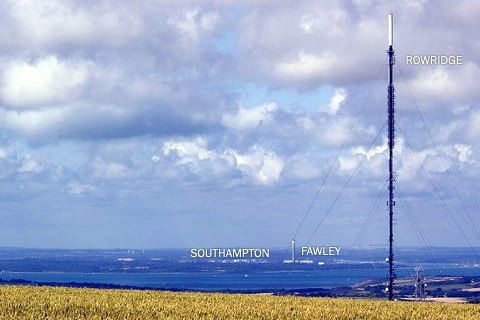
Although the coverage of the Fawley transmitter was not as widespread as that from Rowridge, in Southampton (the area of greatest economic interest) the Channel 5 analogue signal was good enough for most people to watch. Local TV channel Six TV also had a transmitter on the Fawley mast on channel 29 (also in-group) but with the slightly lower 4kW.
As with Six TV above, not all of the original analogue local TV stations used the main station masts.
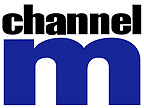 For example, Channel M in Manchester used a site on a water tower in Bolton. Like the Fawley solution for Southampton, this put the transmitter in roughly the right direction for viewers in Manchester whose antennas were pointed at the main station at Winter Hill. The frequency (channel 39) was, however, out of group and the transmitter pattern severely restricted to avoid interference with other transmitters and with the radioastronomy users at Jodrell Bank who used channel 38.
For example, Channel M in Manchester used a site on a water tower in Bolton. Like the Fawley solution for Southampton, this put the transmitter in roughly the right direction for viewers in Manchester whose antennas were pointed at the main station at Winter Hill. The frequency (channel 39) was, however, out of group and the transmitter pattern severely restricted to avoid interference with other transmitters and with the radioastronomy users at Jodrell Bank who used channel 38. 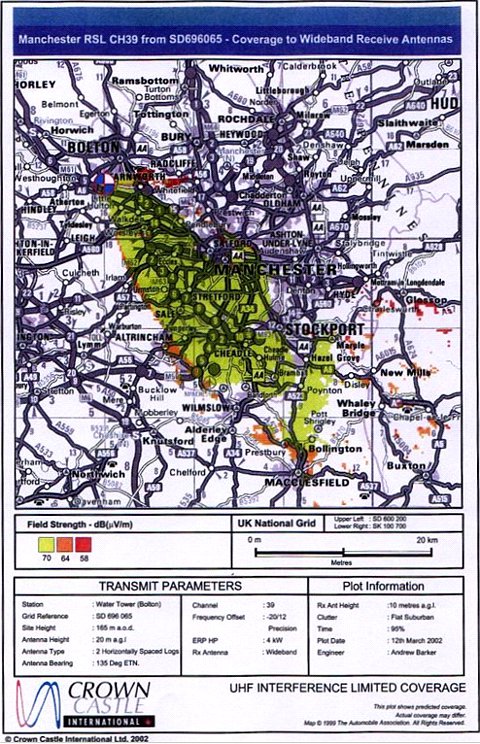 The upshot was that Channel M's signal was strong enough for good reception to a large number of viewers who were nearest to the water tower, but, conversely, coverage of Channel M in downtown Manchester was relatively poor (click on the map on the left to see it in full). Despite that, the station did better than many local TV companies and lasted for the best part of 12 years before finally closing down just before analogue services ended in the UK.
The upshot was that Channel M's signal was strong enough for good reception to a large number of viewers who were nearest to the water tower, but, conversely, coverage of Channel M in downtown Manchester was relatively poor (click on the map on the left to see it in full). Despite that, the station did better than many local TV companies and lasted for the best part of 12 years before finally closing down just before analogue services ended in the UK.What would have been great would to have been able to put more than one site on-air to provide additional coverage to fill-in coverage not-spots. In analogue terms this is difficult to do but for digital services such a solution is inherent to DTT in the form of a single frequency network (SFN). In an SFN multiple transmitters are put on the same frequency and as long as certain technical criteria are maintained (eg the distance between sites is small enough, ensuring that the transmitters are time and frequency synchronised, and that they carry the same content), they do not cause each other interference. In fact, the signals from multiple sites can even add together to improve coverage. If this sounds too good to be true, it is exactly how the digital audio broadcasting (DAB) multiplexes work.
So... Wouldn’t it be great if local TV in the digital age could take advantage of the use of SFNs to put a number of lower power (and thus much cheaper) transmitters right where their audiences are located, in line with existing masts (so that antennas don’t need re-pointing) and providing good coverage where the viewers are, but not wasting power or money on areas where few viewers are located? That is just the solution that Avanti’s bid to run the local TV multiplexes proposes. Whilst it might appear to be a ‘whacky, out-of-the-box’ type of solution, on the contrary it does what needs to be done in an efficient and effective way that has been proven to work well for local TV, even in the days of analogue transmission.
The jury (Ofcom) is still out on which of the bids to operate the multiplexes will succeed, but it is to be hoped that those making the decision are aware of the chequered history of local TV in the UK and don’t fall into the same traps that led to the commercial failure of the original analogue services in the 1990s and 2000s.
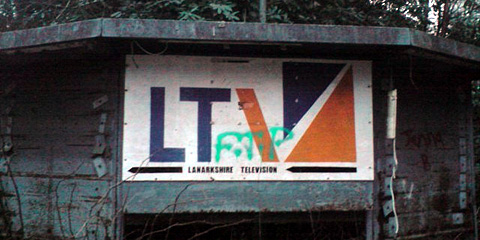
add comment
( 1958 views )
| permalink
| related link
| 



 ( 3 / 452 )
( 3 / 452 )




 ( 3 / 452 )
( 3 / 452 )
Tuesday 23 October, 2012, 07:48 - Licensed
Posted by Administrator
Have you ever read the book 'Freakonomics'? It tries to demonstrate that sometimes cause and effect are far, far removed from each other. Rather like Sherlock Holmes adage:Posted by Administrator
When you have eliminated the impossible, whatever remains, however improbable, must be the truth.
Take a look at the list of FM frequencies for radio stations in Dhaka, Bangladesh. It may not seem odd at first, but look closely:
 88.0 MHz Radio Foorti
88.0 MHz Radio Foorti 88.4 MHz Radio Aamar
88.8 MHz Bangladesh Betar (Traffic Channel)
89.2 MHz ABC Radio
89.6 MHz Radio Today
90.0 MHz Capital FM
 90.4 MHz Dhaka FM
90.4 MHz Dhaka FM91.6 MHz Peoples Radio
92.4 MHz Radio Shadhin
97.6 MHz Bangladesh Betar
100.0 MHz BBC World Service
103.2 MHz Bangladesh Betar (Home Service)
Taken from a variety of sources such as: Asiawaves
Notice anything odd? What about the fact that there are 7 stations spread out every 400 kHz between 88.0 and 90.4, two more below 93 MHz and then the rest of the whole FM band up to 108 MHz contains only 3 more stations.
The 400 kHz spacing is sensible (see the previous Wireless Waffle article on the bandwidth required to transmit a stereo FM programme), but why are they crammed down at the bottom end of the band? Here's a quick Wireless Waffle quiz. See if you can get the right answer.
Is it because:
- Propagation at lower frequencies is better than at higher frequencies and thus the lower end of the FM band will yield marginally better coverage than the top of the band for the same power/antenna.
- Like many countries (including the UK which only had access to 88.0 to 97.6 for a long time), the bottom of the band was opened up for broadcasting first, and the upper frequencies have only recently become available.
- Buildings in Dhaka are built to a Government controlled specification which, ironically, has a resonant frequency at the top of the FM band, causing signals at this end of the band not to be able to penetrate inside them.
- The majority of cars in Dhaka are imported from Japan which has an odd FM broadcasting band that runs from 76 to 90 MHz and thus the radios in those cars don't extend much above 90 MHz.
- The transmitters used by FM stations in Dhaka are very old and work best at the lowest possible frequency, giving the highest output power and greatest efficiency.
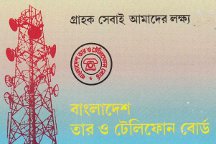 Well (a) is certainly true, though the difference in propagation is less than 20% between 88 and 108 MHz and is offset to some extent by the slightly better performance of receiving antennas at 108 compared to 88 MHz. As for (b), this is not true as the BBC service on 100 MHz has been on air for over 15 years and was one of the first FM stations in Dhaka. Answer (c) is a joke – have you seen the state of buildings in Dhaka?! Answer (d) could certainly be true as the Japanese FM band does run from 76 to 90 MHz. And finally (e) would be true of old transmitters were used, but most are modern and therefore don't suffer from this problem, which, as with (a) is pretty marginal anyhow.
Well (a) is certainly true, though the difference in propagation is less than 20% between 88 and 108 MHz and is offset to some extent by the slightly better performance of receiving antennas at 108 compared to 88 MHz. As for (b), this is not true as the BBC service on 100 MHz has been on air for over 15 years and was one of the first FM stations in Dhaka. Answer (c) is a joke – have you seen the state of buildings in Dhaka?! Answer (d) could certainly be true as the Japanese FM band does run from 76 to 90 MHz. And finally (e) would be true of old transmitters were used, but most are modern and therefore don't suffer from this problem, which, as with (a) is pretty marginal anyhow.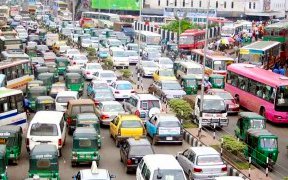 The real reason that stations in Dhaka are clustered on frequencies around and below 90 MHz is (d). Think about it... when you listen to FM radio the most? Yes, perhaps you listen at home, especially on your alarm clock and in the morning, but most listening is done whilst in the car. There’s not much point being on a frequency that car radios can’t tune into and so there is the highest demand for frequencies on or below 90 MHz. Some older analogue radios will tune slightly above this so 90.4 MHz and thereabouts is not bad either. At the time of launch of the BBC service on 100 MHz there were very few cars (or FM radios for that matter) in Dhaka and so the issue didn't manifest itself.
The real reason that stations in Dhaka are clustered on frequencies around and below 90 MHz is (d). Think about it... when you listen to FM radio the most? Yes, perhaps you listen at home, especially on your alarm clock and in the morning, but most listening is done whilst in the car. There’s not much point being on a frequency that car radios can’t tune into and so there is the highest demand for frequencies on or below 90 MHz. Some older analogue radios will tune slightly above this so 90.4 MHz and thereabouts is not bad either. At the time of launch of the BBC service on 100 MHz there were very few cars (or FM radios for that matter) in Dhaka and so the issue didn't manifest itself.Did you guess right? Would you have guessed that the choice of FM frequencies was driven by car imports if it hadn't been suggested to you? We doubt it! A case of 'Freakonomics' that is perhaps best labelled 'Freakquencies'.
 Apparently, mobile phone operators are beginning to run out of capacity on their networks due to all the data traffic that is being generated by smart-phones and people using broadband dongles in their laptops. Of course, whether or not this is true or not today or whether it is just an excuse for poor service quality, there will almost certainly come a time in the relatively near future when it the squeeze on spectrum becomes reality.
Apparently, mobile phone operators are beginning to run out of capacity on their networks due to all the data traffic that is being generated by smart-phones and people using broadband dongles in their laptops. Of course, whether or not this is true or not today or whether it is just an excuse for poor service quality, there will almost certainly come a time in the relatively near future when it the squeeze on spectrum becomes reality.A typical mobile operator in an average European country will currently have access to something like 100 MHz of radio spectrum - 50 MHz for the uplink from phones to base stations and another 50 MHz in the opposite direction - more commonly written 2 x 50 MHz. This will be in usually two (or more) of the commonly available mobile bands, such as:
- 900 MHz (actually 880 - 915 and 925 - 960 MHz)
- 1800 MHz (1710 - 1785 and 1805 - 1880 MHz)
- 2100 MHz (1920 - 1980 and 2110 - 2170 MHz)
- 800 MHz (791 - 821 and 832 - 862 MHz) - the 'digital dividend'
- 2600 MHz (2500 - 2570 and 2620 - 2690 MHz) - note that the gap between 2570 and 2620 MHz is also available
So what's the problem? Some observers (eg Cisco) claim that mobile data traffic is doubling roughly every year, so this 60% increase in capacity will amount to about 8 months of traffic growth, then the problem starts all over again. New technology will deal with some growth. Newer mobile technologies from HSPA+ to LTE and LTE-Advanced may offer a doubling in capacity over current 3G (UMTS) networks for each unit of spectrum. Another year dealt with, and only at the cost of changing over all of the network equipment and handsets!
On this front, it is perhaps no surprise that UK mobile operator O2 recently announced plans to offer free WiFi for all. Why is this no surprise? If the traffic from smartphones and laptops can be offloaded from the mobile network to WiFi hotspots, this will ease the burden on the mobile network. But this is a relatively short-term fix too. In the long term, the only way that mobile operators will be able to deal with the growth in data traffic is to get access to more spectrum. But where will this spectrum come from?
It has long been recognised that to offer a sensible (in terms of cost, coverage and capacity) mobile network, frequencies in the range 300 to 3000 MHz are best. Go any higher and things such as Doppler shift and cell handover become real problems. Go any lower and antennas become too large and unwieldy. The problem is that the remaining frequencies in this range are already being used. In general terms:
- 300 to 430 MHz is military territory
- 430 to 440 MHz is radio amateur land
- 440 to 470 MHz is full with PMR systems
- 470 to 790 MHz has UHF television broadcasters in it
- 790 to 862 MHz is already mobile
- 862 to 880 MHz houses all manner of low power devices
- 880 to 960 MHz is already mobile
- 960 to 1350 MHz is where aircraft radars and some radio amateurs live
- 1350 to 1710 MHz is for satellites (including GPS and weather satellites), DAB broadcasting and more tanks, planes and guns
- 1710 to 1980 MHz is already mobile
- 1980 to 2110 MHz is partly mobile and partly full of military folk
- 2110 to 2170 MHz is already mobile
- 2170 to 2400 MHz is mostly military
- 2400 to 2500 MHz is WiFi and bluetooth land
- 2500 to 2690 MHz is already mobile
- 2690 to 2700 MHz is where radio astronomers hang out (mostly in cardigans)
- 2700 to 3100 MHz is aircraft and maritime radars
Clearly, anyone who moves out for the benefit of mobile services will either have to stop doing what they do (unlikely) or go and do it somewhere else (costly). For any international service (eg boats and planes) this cannot be done unilaterally and getting international agreement is probably too slow. What's more, radars and things such as that need a lot of spectrum due to the way they work and furthermore, removing them might cause planes to fall out of the sky, which would seriously disrupt tourism in many parts of Europe that aren't very close to where you live (though it might have a potential commercial upside for undertakers).
Wireless Waffle is therefore going to stick it's neck out and make a proposal as to who should lose the battle for this important part of the spectrum and that is ... the broadcasters!
On a completely different, but not unrelated tack, the amount of energy consumed by a terrestrial broadcasting networks is, well, large. Not 'a whole power station' large, but still pretty big. The amount of energy consumed by a satellite is tiny. In fact, once it's up in the sky, it's zero (they are solar powered). A terrestrial broadcast network also delivers much less capacity than a satellite. So broadcasting by satellite consumes much less power (and therefore has a much lower carbon footprint) and offers much greater capacity (for services such as 'The Cartoon Network' in HD). Let's therefore turn off UHF broadcasting and give the spectrum to mobile networks - the broadcasters can go to cable and satellite and can continue to use the VHF band if they really want to.
What would a world without UHF broadcasting look like. In somewhere such as the Netherlands where 90% or more of homes are on cable, not a lot different. It would mean that people's holiday homes might need a satellite dish but these are so cheap and plentiful it should be no big deal. In the UK where most homes still have a terrestrial UHF receiver you might think this would be a bigger deal, but over 50% of homes have either satellite or cable already and again, having to buy a dish is no biggie, so other than the temporary inconvenience of swapping set top boxes and putting a dish up (or getting connected to cable) nothing much would change.
If they so desired, public service broadcasters could continue terrestrial television broadcasting using the VHF band - by switching off those ancient and largely unlistened-to DAB transmitters. DAB could be replaced by DRM and Bob's your uncle - no loss of anything important, just a bit of shuffling around.
If all this sounds far fetched, watch this space. Or, perhaps more accurately, watch outer space!
Thursday 12 March, 2009, 09:00 - Licensed
Posted by Administrator
Posted by Administrator
 Have you ever tuned into your local radio station and heard the travel news being read out from the 'eye in the sky' - a presenter checking out the traffic from an aircraft high over the area concerned? Have you ever stopped to think how that is done? Well Wireless Waffle is here to help explain it all.
Have you ever tuned into your local radio station and heard the travel news being read out from the 'eye in the sky' - a presenter checking out the traffic from an aircraft high over the area concerned? Have you ever stopped to think how that is done? Well Wireless Waffle is here to help explain it all.There is no denying that it would be very easy for any radio station to pretend to have a traffic plane or helicopter by playing sound effects in the background whilst the travel news was read out. However, there are some real benefits about doing it properly, not least it is possible to find out how the traffic is flowing as and when problems occur instead of waiting for listeners to phone in news (which can be unreliable) or for the local police or traffic department to let you know what's happening. But that doesn't mean that the aircraft in question can necessarily see all the problems in an area and in some cases, it is not possible to fly over certain areas due to airspace restrictions (for example, it would not make sense for a 'traffic plane' to be buzzing around a major airport, stopping commercial airliners from landing!)
What happens, therefore, is that there is someone on the ground who collates traffic information in the normal way (eg through listeners or the police) and then relays this information to the man in the aircraft. The plane (or chopper) can then visit some of the travel hotspots and see what is happening and if, along the way, they see other problems that haven't been reported, they can update the person on the ground. This means that, in general, travel news from an aircraft is more accurate and up-to-date than travel news from a regular travel studio.
From the technology perspective, there is lots of radio used (hence the Wireless Waffle interest). For starters, the pilot will be communicating with various air traffic controllers on the VHF aeronautical band (117.975 to 137.000 MHz).
 Next, there is a need for the person on the ground, including the presenter in the radio studio, to be able to communicate with the presenter in the aircraft - the 'uplink'. Typically this is done via a simple VHF or UHF PMR frequency (in the UK try listening around 141.000 to 141.500 MHz and 455.000 to 455.500 MHz). As well as passing travel news to the airborne presenter, this frequency is also often used as the 'cue', providing a live feed of the station on which the travel news is to be broadcast so that the airborne presented knows when to start reading the news.
Next, there is a need for the person on the ground, including the presenter in the radio studio, to be able to communicate with the presenter in the aircraft - the 'uplink'. Typically this is done via a simple VHF or UHF PMR frequency (in the UK try listening around 141.000 to 141.500 MHz and 455.000 to 455.500 MHz). As well as passing travel news to the airborne presenter, this frequency is also often used as the 'cue', providing a live feed of the station on which the travel news is to be broadcast so that the airborne presented knows when to start reading the news.Finally there is a the link from the airborne presenter to the ground - the 'downlink'. This is usually (but not always) a slightly higher quality link than the uplink as the audio is going to be broadcast. In the UK, these links are usually at UHF (try between 467.250 and 469.900 MHz). As they are transmitted from the aircraft, despite being low power, they can often be heard over a wide area.
If the aircraft is providing travel news for a wide area, more than one up and/or downlink might be used for the different areas, depending on whether or not frequencies which can be used over a wide area are available.
In some countries, the presenter uplink and downlink are also in the aeronautical VHF band (this is the case, for example, in Malta), and the frequencies use do vary significantly between countries. If you are in an area where the local radion station has a travel plane or helicopter, why not have a tune around and see what you can find and post a comment to let us all know.

